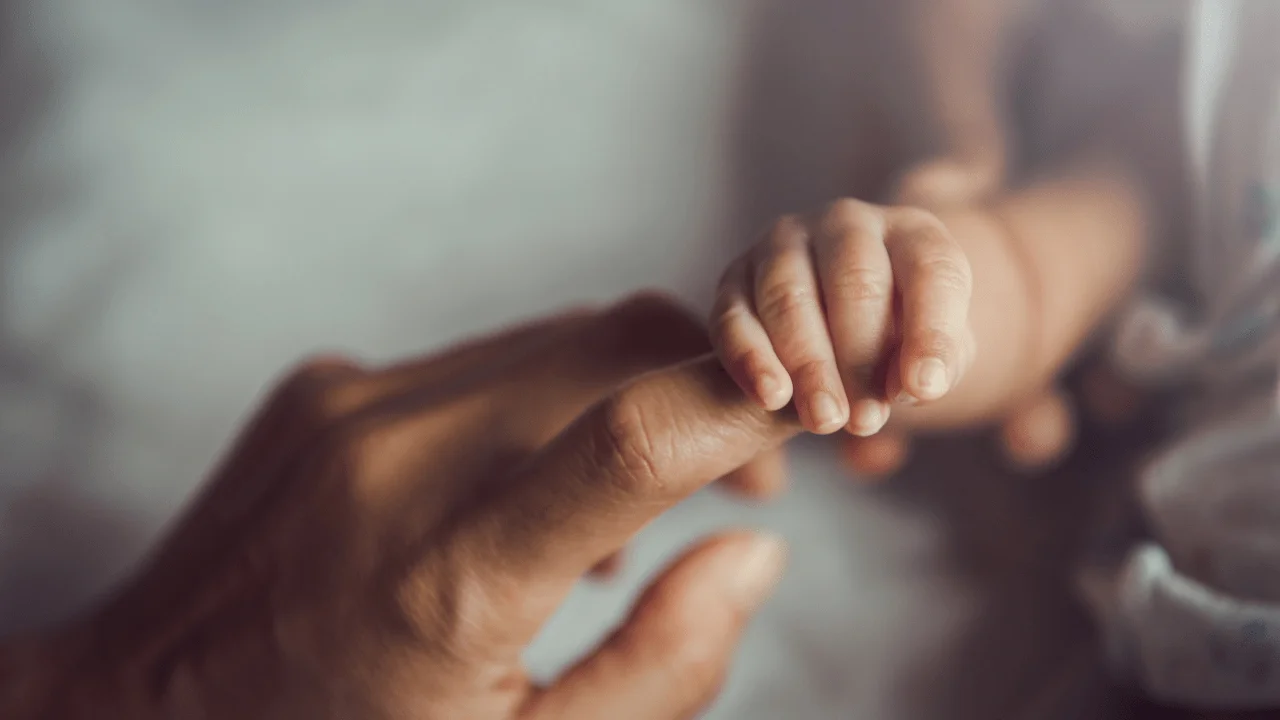
አዲስ የተወለዱ ምላሾች። ጨቅላ ሕፃናት የተወለዱት በበርካታ ምላሾች ነው - ለአንድ ነገር ምላሽ የሚከሰቱ አውቶማቲክ እንቅስቃሴዎች። Moro reflex የሚከሰተው ልጅዎ ሲደነግጥ ነው፣ ለምሳሌ፣ እና ረሃብ የስርወ መነቃቃትን ያነሳሳል። ጣትዎን በልጅዎ መዳፍ ውስጥ ሲያስገቡ፣ የሚይዘው ሪፍሌክስ አራስ ልጅዎ በደመ ነፍስ ጥቃቅን ጣቶቻቸውን በጣቶቻዎ ላይ እንዲጠመምም ያስችለዋል። ሌሎች አዲስ የተወለዱ ምላሾች የ"አጥር" (ቶኒክ አንገት) ምላሽ፣ የእርምጃ ምላሽ እና የመምጠጥ ምላሽ ያካትታሉ።
በዚህ ጽሑፍ ውስጥ
- Moro reflex ምንድን ነው?
- በጨቅላ ሕፃናት ውስጥ የስርወ-ወሊድ ምላሽ ምንድነው?
- የእርምጃ ምላሽ ምንድን ነው?
- በሕፃናት ላይ የ Babinski reflex ምንድን ነው?
- ሌሎች አዲስ የተወለዱ ምላሾች ምንድናቸው?
የልጅዎ አዲስ የተወለዱ ምላሾች - የእድገት ምላሽ ወይም primitive reflexes የሚባሉት - በማዕከላዊው የነርቭ ስርዓታቸው የሚቀሰቅሱ የመትረፍ ደመ-ነፍስ ናቸው። ሪፍሌክስ ድንገተኛ እንቅስቃሴ ሊሆን ይችላል፣ ግን አብዛኛውን ጊዜ ለአንድ ነገር ምላሽ ነው - እንደ ድንገተኛ ድምፅ ወይም እንቅስቃሴ፣ ወይም የሆነ ነገር በእጃቸው ወይም በጉንጫቸው ላይ ያለው ስሜት።
እነዚህን እንቅስቃሴዎች ለማበረታታት ምንም ነገር ማድረግ አያስፈልግዎትም፣ ነገር ግን ልጅዎ ከእነዚህ ምላሾች ውስጥ አንዱ ያለው የማይመስል ከሆነ፣ በሰውነታቸው በአንደኛው በኩል ካላቸው ነገር ግን በሌላኛው በኩል ካልሆነ (ወይም በሁለቱም በኩል እኩል ጥንካሬ ከሌለው) ወይም ሪፍሌክስ በሚጠበቀው ጊዜ ውስጥ የማይጠፋ ከሆነ ለልጅዎ የጤና እንክብካቤ አቅራቢ ይንገሩ። እነዚህ ምልክቶች የሕፃኑ አእምሮ ወይም የነርቭ ሥርዓት ችግር እንዳለበት የሚያሳዩ ምልክቶች ሊሆኑ ይችላሉ።
አብዛኛዎቹ አዲስ የተወለዱ ምላሾች በመጀመሪያው ዓመት ውስጥ ይጠፋሉ፣ ነገር ግን አንዳንዶቹ ወደ ጉልምስና ዕድሜ ይቆያሉ። ጎልማሶች እንደመሆናችን መጠን ከልጅነት ጊዜ ጀምሮ እንዳደረግነው ሁሉ አሁንም ብልጭ ድርግም እንላለን፣ እናስላቸዋለን፣ እንጋጫለን፣ እናስነጥቃለን እና እናዛጋለን።
Moro reflex ምንድን ነው?
ከፍተኛ ድምጽ ወይም ድንገተኛ እንቅስቃሴ ልጅዎ ጀርባውን እንዲሰርዝ፣ እግሮቹን እና እጆቹን እንዲዘረጋ፣ ምናልባትም ያለቅሳል፣ እና እጆቻቸውንና እግሮቻቸውን ወደ ውስጥ እንዲመልሱ ሊያደርግ ይችላል። እንዲሁም የሕፃኑ ጭንቅላት በፍጥነት ቦታውን ከቀየረ ወይም ጭንቅላታቸው ወደ ኋላ ቢወድቅ (ወይም ትንሽ በፍጥነት ብታስቀምጣቸውም) ሊከሰት ይችላል። እሱ ሞሮ ወይም ስታርትል ሪፍሌክስ ይባላል፣ እና እራሳቸውን ለመጠበቅ ያለፈቃድ ጥረት ነው።
የራሳቸው ጩኸት ወይም ድንገተኛ እንቅስቃሴ እንኳን የሞሮ ሪፍሌክስን ለመቀስቀስ የሚያስችል ህፃን ሊያስደንቅ ይችላል። ይህ ሪፍሌክስ እንቅልፋቸውን ሊያቋርጥ ይችላል - ነገር ግን ይህንን ለመከላከል እና ልጅዎን ከመደንገጥ የሚያግዱባቸው መንገዶች አሉ።
Moro reflex የሚፈጠረው ልጅዎ ገና በማህፀን ውስጥ እያለ፣ በ32 ሳምንታት እርግዝና ላይ ነው። ከተወለደ በኋላ ባለው የመጀመሪያው ወር ውስጥ ከፍተኛ ደረጃ ላይ ይደርሳል እና ብዙውን ጊዜ በ 2 ወር አካባቢ ይጠፋል. አንዳንድ ጊዜ ድንጋጤ ለሦስት ወይም ለአራት ወራት ሊቀጥል ይችላል. አንዳንድ ጨቅላዎች ከረጅም ጊዜ በላይ መገረማቸውን ይቀጥላሉ፣ ነገር ግን ልጅዎ ከ6 ወራት በኋላ ገና የመነሻ ምላሽ ካገኘ፣ ሃኪማቸውን ያነጋግሩ።
በጨቅላ ሕፃናት ውስጥ የስርወ-ወሊድ ምላሽ ምንድነው?
ልጅዎ ከወለዱ በኋላ ለመጀመሪያ ጊዜ ምግባቸው ስር ሲሰድ አጋጥሞዎት ሊሆን ይችላል። ይህ ሪፍሌክስ የጡት ጫፉን ፈልገው ማጥባት እንዲጀምሩ ይረዳቸዋል። የልጅዎን ጉንጭ፣ ከንፈር ወይም የአፋቸውን ጎን በጡት ጫፍዎ (ወይ የጡጦውን ጫፍ፣ ወይም ደግሞ ጣት) ይንኩ እና መመገብን በመጠባበቅ ወደ እሱ ዘወር ይላሉ፣ አፉ ይከፈታል። የመጥባት እንቅስቃሴን እንኳን ሊጀምሩ ይችላሉ።
አንድ ሕፃን ሥር ሲሰድ, ቆንጆ ብቻ ሳይሆን - የተራበ መሆኑን የሚያሳይ ጥሩ ምልክት ነው.
ህጻናት የሚወለዱት ስርወ-ነቀል (rooting reflex) ሲሆን እስከ 4 ወር እድሜ ድረስ ይቆያል።
የእርምጃ ምላሽ ምንድን ነው?
ይህ አስገራሚ ምላሽ የእግር ጉዞ ወይም ዳንስ ሪፍሌክስ ተብሎም ይጠራል። ልጅዎን በእግራቸው ጠፍጣፋ መሬት ላይ በማያያዝ ቀጥ ብለው ይያዙት እና እርምጃዎችን የሚወስዱ ይመስላሉ, ቀስ ብለው ማራዘም እና አንዱን እግር ከሌላው በኋላ በማጠፍጠፍ. በእርግጥ ልጅዎ ክብደታቸውን መደገፍ አይችልም, ግን በእርግጠኝነት የሚራመዱ ወይም የሚጨፍሩ ይመስላል!
ይህ ምላሽ ወደ 2 ወር አካባቢ ይጠፋል። ልጅዎ ሲማር መራመድ -በተለምዶ ከ9 እስከ 15 ወር ባለው ጊዜ ውስጥ፣ ምንም እንኳን አንዳንድ ህፃናት እስከ 18 ወር ድረስ ባይራመዱም - እንቅስቃሴው በፍቃደኝነት እና ከአሁን በኋላ ምላሽ ሰጪ አይሆንም። እሱ ጥንካሬን ፣ ሚዛንን እና ጥሩ በራስ መተማመንን ያካትታል።
በሕፃናት ላይ የ Babinski reflex ምንድን ነው?
የልጅዎን እግር ግርጌ ይምቱ እና ትልቁን የእግር ጣት ወደ እግሩ አናት መልሰው ያስረዝማሉ እና የሌሎቹን ጣቶች ያራግፉ። ይህ በአስራ ዘጠነኛው ክፍለ ዘመን መገባደጃ ላይ ለመጀመሪያ ጊዜ የገለፀው በፈረንሳዊው የነርቭ ሐኪም ጆሴፍ ባቢንስኪ የተሰየመው የፕላንተር ሪፍሌክስ ወይም Babinski reflex ይባላል።
ይህ ሪፍሌክስ እስከ 12 ወር እና 2 ዓመት ድረስ ይቆያል። Babinski reflex ከ 2 በላይ በሆነ ልጅ ላይ (ወይም በአዋቂዎች ላይ የሚታየው) እንደ ማዕከላዊ የነርቭ ሥርዓት መዛባት ምልክት ሊሆን ይችላል የማጅራት ገትር በሽታ, ስትሮክ ወይም ኒውሮዲጄኔቲቭ በሽታ.
ሌሎች አዲስ የተወለዱ ምላሾች ምንድናቸው?
በመጨበጥ (palmar) reflex
ልጅዎ እስከ 6 ወር እድሜ ድረስ ሆን ብሎ ነገሮችን በአስተማማኝ ሁኔታ መያዝ አይችልም። እስከዚያው ድረስ፣ በብዙ ጣፋጭ የጨቅላ ሕጻናት ፎቶዎች ላይ የሚታየው የመረዳት ችሎታ አላቸው።
ጣትዎን በልጅዎ መዳፍ ውስጥ ያድርጉት, እና ትንሽ ጣቶቻቸውን በዙሪያው ይጠቀለላሉ. ጣትዎን ለማንሳት ከሞከሩ ልጅዎ እጁን ሊያጥብ ይችላል። ለአሁን በደመ ነፍስ ነው, እና ጠንካራ ስሜት ይሰማዋል, ነገር ግን በእሱ ላይ አይመሰረቱ. ልጅዎ በጣም በድንገት ሊለቅ ይችላል. ይህ palmar reflex ይባላል እና በ 32 ሳምንታት እርግዝና የተመሰረተ ነው. ልጅዎ ከ 5 እስከ 6 ወር እድሜ እስኪኖረው ድረስ ይቆያል.
የሚጠባ reflex
የልጅዎን አፍ ጣራ ይንኩ, እና መምጠጥ ይጀምራሉ - ጡት, ጣት, ማጥመጃ, እዚያ ውስጥ የሚሠራው. ከእጅ ወደ አፍ ምላሽ መስጠት የሚጠባውን ምላሽ ያሟላል - ይህም አንድ ሕፃን የራሱን አውራ ጣት ወይም ጣቶች መምጠጥ የሚጀምረው በዚህ መንገድ ነው።
ጨቅላ በቡጢ ሲጠቡ የአልትራሳውንድ ፎቶዎችን አይተህ ይሆናል። ይህ የሰርቫይቫል ሪፍሌክስ ከ21 እስከ 24 ሳምንታት ባለው የእርግዝና ወቅት ማደግ ይጀምራል ግን እስከ 36 ሳምንታት ድረስ ሙሉ በሙሉ አያድግም። (ለዚህም ነው አንዳንድ ያልተወለዱ ሕፃናት ጠንካራ የሚጠባ ምላሽ ላይኖራቸው ይችላል።) በተጨማሪም፣ ለመተንፈስ፣ ለመምጠጥ እና ለመዋጥ የተወሰነ ቅንጅት ያስፈልጋል፣ ስለዚህ አንዳንድ ህጻናት በብቃት መብላትን ለመማር ትንሽ ጊዜ ያስፈልጋቸዋል።
ቶኒክ ሪፍሌክስ
አንዴ ልጅዎ ይህንን ቦታ ሲመታ፣ ለምን "የአጥር መነቃቃት" ተብሎም እንደሚጠራ ያያሉ። (ዶክተሮች asymmetrical tonic neck reflex ብለው ይጠሩታል።) ልጅዎ ጀርባው ላይ ሲተኛ፣ ጭንቅላታቸውን ወደ አንድ ጎን ካዞሩ፣ ተቃራኒው ክንድ በክርን ላይ ሲታጠፍ በዚያ በኩል ያለው ክንድ ይዘረጋል። የልጅዎን ጭንቅላት ወደ ሌላኛው ጎን ያዙሩት, እና በተቃራኒው ክንድ በሚታጠፍበት ጊዜ ክንድ በዚያ በኩል ይደርሳል.
ይህ እንቅስቃሴ አንዳንድ ጊዜ ስውር ሊሆን ይችላል፣ እና ልጅዎ ከተናደደ ወይም ካለቀሰ ላያደርገው ይችላል።
ቶኒክ ሪፍሌክስ በ 35 ሳምንታት እርግዝና ላይ ያድጋል እና ህጻኑ ከ 5 እስከ 7 ወር እድሜ ድረስ ይቆያል.
ጋላንት (የግንድ ኩርባ)
ወደ ታች በሚወርድበት ጊዜ የልጅዎ አከርካሪ ከጎን በኩል ምታ ያድርጉ እና ወገባቸውን ወደሚያነቃቁት ጎን ያዞራሉ። አንድ ሕፃን ከተወለደ በኋላ ለአንድ ወይም ለሁለት ወራት ይህን ያደርጋል.
የፓራሹት ሪፍሌክስ
ልጅዎ በዚህ ጠቃሚ ሪፍሌክስ አልተወለደም, ነገር ግን በ 8 ወይም 9 ወር አካባቢ ያዳብሩታል እና ለህይወት ያቆዩታል. ከተሰናከሉ እና ከወደቁ በደመ ነፍስ እጆችዎን ወደ መሬት እንዴት እንደሚዘረጋ ያውቃሉ? በስራ ላይ ያንተ የፓራሹት ሪፍሌክስ ነው። (እንደ ፓራሹት እራስህን ከውድቀት እየጠበቅክ ነው።)
ትልቁ ልጅህ ይህን ሪፍሌክስ እንዳዳበረ ለማየት፣ ይህን ሙከራ ሞክር። ልጅዎን በአስተማማኝ ሁኔታ ቀጥ አድርገው ይያዙት ፣ ጀርባቸው ወደ እርስዎ ያይ። በጥንቃቄ ነገር ግን በፍጥነት ሰውነታቸውን ወደ ፊት አዙረው፣ እንደወደቁ ወደ ታች ይመለከቱ። ልጅዎ እጆቹን ወደ መሬት ይዘረጋል, ብዙውን ጊዜ ጣቶች በስፋት ይሰራጫሉ. ምናልባት ሕፃናት መራመድ ከመማር ጥቂት ቀደም ብለው ይህንን ሪፍሌክስ ማዳበሩ በአጋጣሚ ላይሆን ይችላል!
ተጨማሪ ያንብቡ


አስተያየት ጨምር